height TOYOTA TACOMA 2010 Owners Manual (in English)
[x] Cancel search | Manufacturer: TOYOTA, Model Year: 2010, Model line: TACOMA, Model: TOYOTA TACOMA 2010Pages: 532, PDF Size: 15.03 MB
Page 57 of 532
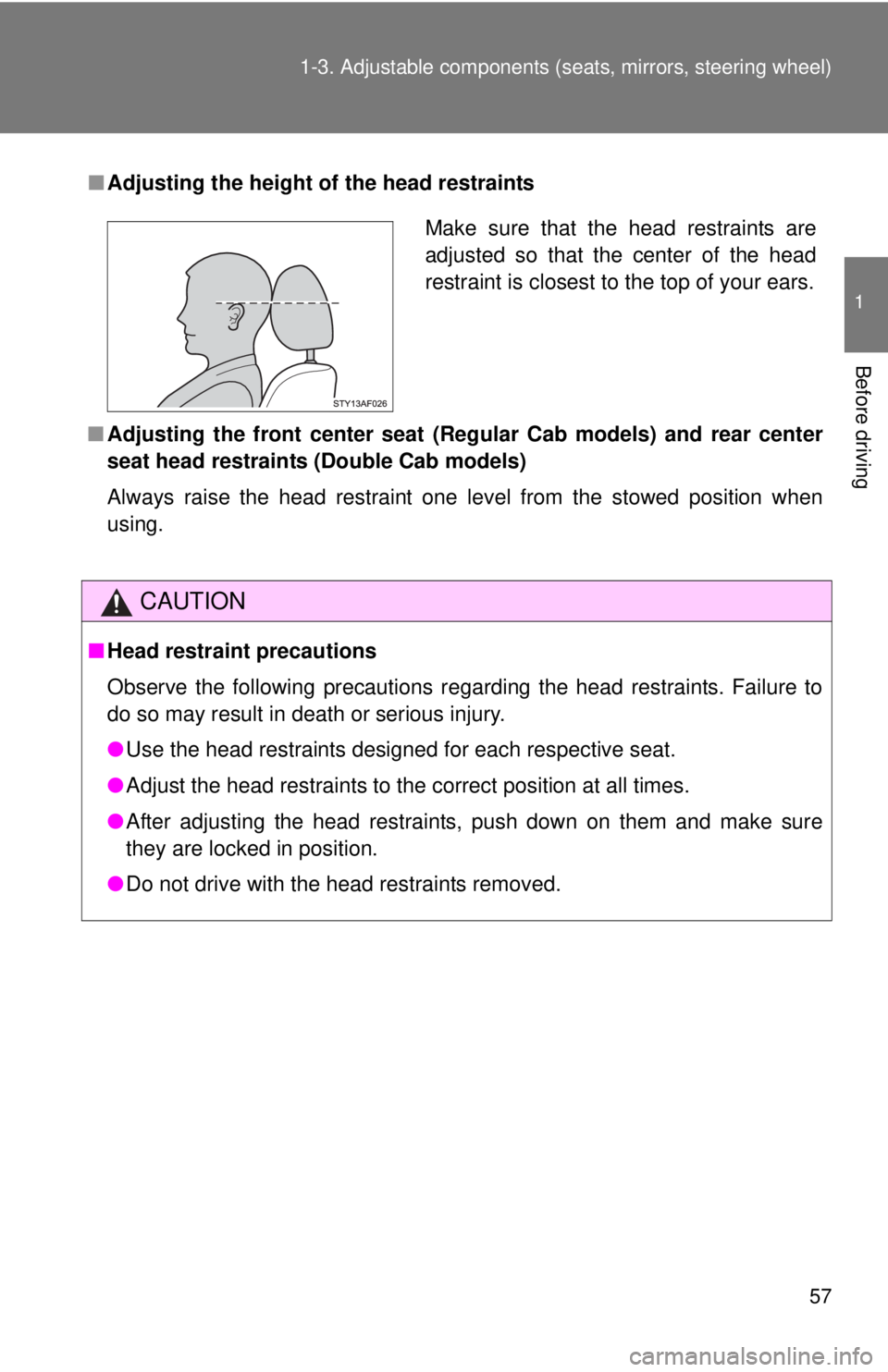
57 1-3. Adjustable components (seats, mirrors, steering wheel)
1
Before driving
■Adjusting the height of the head restraints
■Adjusting the front center seat (Regular Cab models) and rear center
seat head restraints (Double Cab models)
Always raise the head restraint one level from the stowed position when
using.
CAUTION
■Head restraint precautions
Observe the following precautions regarding the head restraints. Failure to
do so may result in death or serious injury.
●Use the head restraints designed for each respective seat.
●Adjust the head restraints to the correct position at all times.
●After adjusting the head restraints, push down on them and make sure
they are locked in position.
●Do not drive with the head restraints removed.
Make sure that the head restraints are
adjusted so that the center of the head
restraint is closest to the top of your ears.
Page 59 of 532
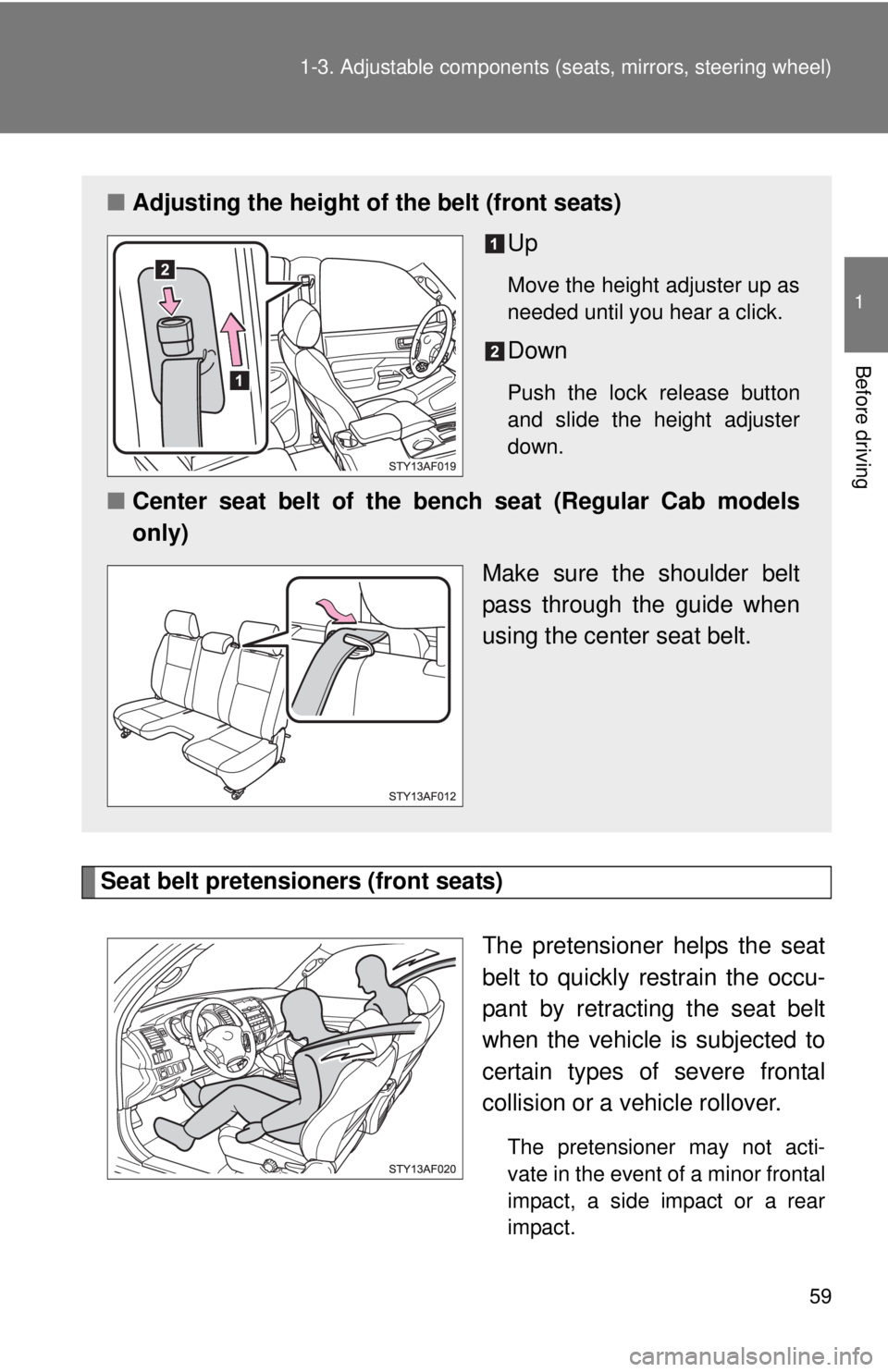
59 1-3. Adjustable components (seats, mirrors, steering wheel)
1
Before driving
Seat belt pretensioners (front seats)
The pretensioner helps the seat
belt to quickly restrain the occu-
pant by retracting the seat belt
when the vehicle is subjected to
certain types of severe frontal
collision or a vehicle rollover.
The pretensioner may not acti-
vate in the event of a minor frontal
impact, a side impact or a rear
impact.
■Adjusting the height of the belt (front seats)
Up
Move the height adjuster up as
needed until you hear a click.
Down
Push the lock release button
and slide the height adjuster
down.
■Center seat belt of the bench seat (Regular Cab models
only)
Make sure the shoulder belt
pass through the guide when
using the center seat belt.
Page 197 of 532
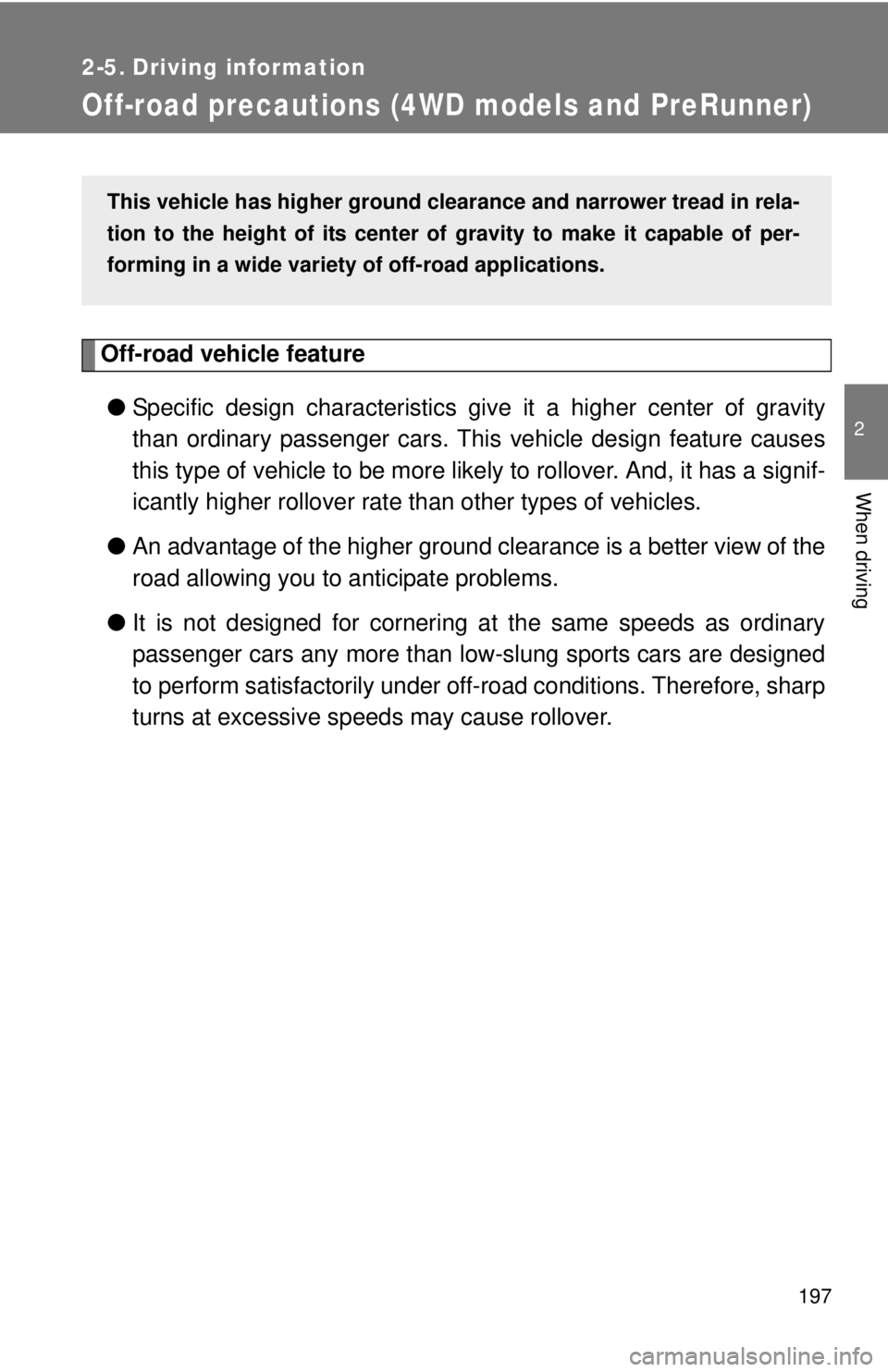
197
2
When driving
2-5. Driving information
Off-road precautions (4WD models and PreRunner)
Off-road vehicle feature
●Specific design characteristics give it a higher center of gravity
than ordinary passenger cars. This vehicle design feature causes
this type of vehicle to be more likely to rollover. And, it has a signif-
icantly higher rollover rate than other types of vehicles.
●An advantage of the higher ground clearance is a better view of the
road allowing you to anticipate problems.
●It is not designed for cornering at the same speeds as ordinary
passenger cars any more than low-slung sports cars are designed
to perform satisfactorily under off-road conditions. Therefore, sharp
turns at excessive speeds may cause rollover.
This vehicle has higher ground clearance and narrower tread in rela-
tion to the height of its center of gravity to make it capable of per-
forming in a wide variety of off-road applications.
Page 219 of 532
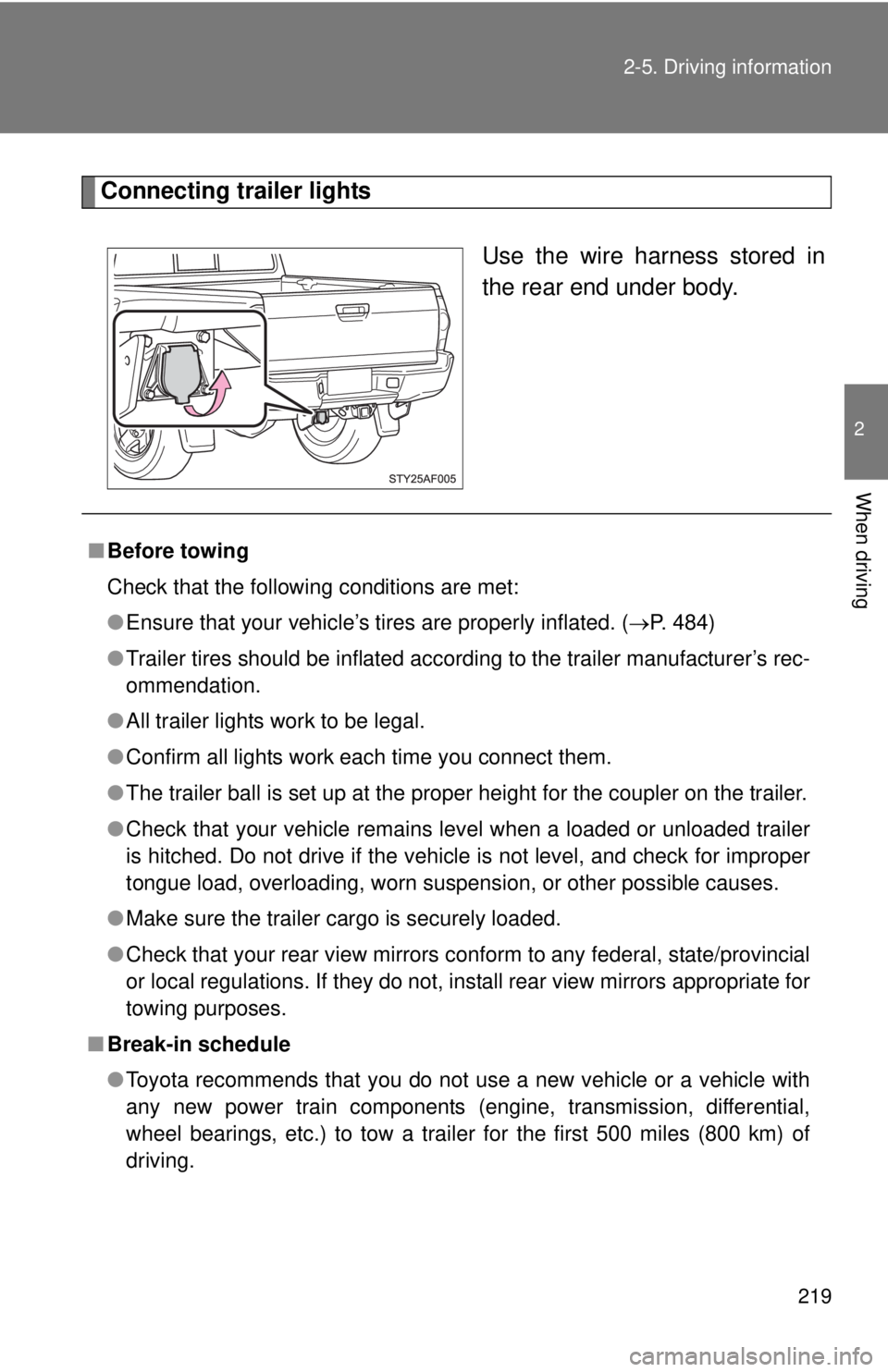
219 2-5. Driving information
2
When driving
Connecting trailer lights
Use the wire harness stored in
the rear end under body.
■Before towing
Check that the following conditions are met:
●Ensure that your vehicle’s tires are properly inflated. (P. 484)
●Trailer tires should be inflated according to the trailer manufacturer’s rec-
ommendation.
●All trailer lights work to be legal.
●Confirm all lights work each time you connect them.
●The trailer ball is set up at the proper height for the coupler on the trailer.
●Check that your vehicle remains level when a loaded or unloaded trailer
is hitched. Do not drive if the vehicle is not level, and check for improper
tongue load, overloading, worn suspension, or other possible causes.
●Make sure the trailer cargo is securely loaded.
●Check that your rear view mirrors conform to any federal, state/provincial
or local regulations. If they do not, install rear view mirrors appropriate for
towing purposes.
■Break-in schedule
●Toyota recommends that you do not use a new vehicle or a vehicle with
any new power train components (engine, transmission, differential,
wheel bearings, etc.) to tow a trailer for the first 500 miles (800 km) of
driving.
Page 452 of 532

452 5-2. Steps to take in an emergency
CAUTION
■Using the jack
Improper use of the jack may lead to death or serious injuries due to the
vehicle suddenly falling off the jack.
●Do not use the jack for any purpose other than replacing tires or install-
ing and removing tire chains.
●Only use the jack that comes with this vehicle for replacing a flat tire.
Do not use it on other vehicles, and do not use other jacks for replac-
ing tires on this vehicle.
●Always check that the jack is securely set to the jack point.
●Do not put any part of your body under the vehicle supported by a jack.
●Do not start or run the engine while your vehicle is supported by the
jack.
●Do not raise the vehicle while someone is in it.
●When raising the vehicle, do not put an object on or under the jack.
●Do not raise the vehicle to a height greater than that required to
replace the tire.
●Use a jack stand if it is necessary to get under the vehicle.
Take particular care when lowering the vehicle to ensure that no one
working on or near the vehicle will be injured.
■Using the jack handle
Tighten all the screws securely to prevent the extension parts from com-
ing apart unexpectedly.
■Replacing a flat tire
Observe the following precautions to reduce the risk of death or serious
injury.
●Lower the spare tire completely to the ground before removing it from
under the vehicle.
●Do not try to remove the wheel ornament by hand. Take due care in
handling the ornament to avoid unexpected personal injury.
Page 470 of 532
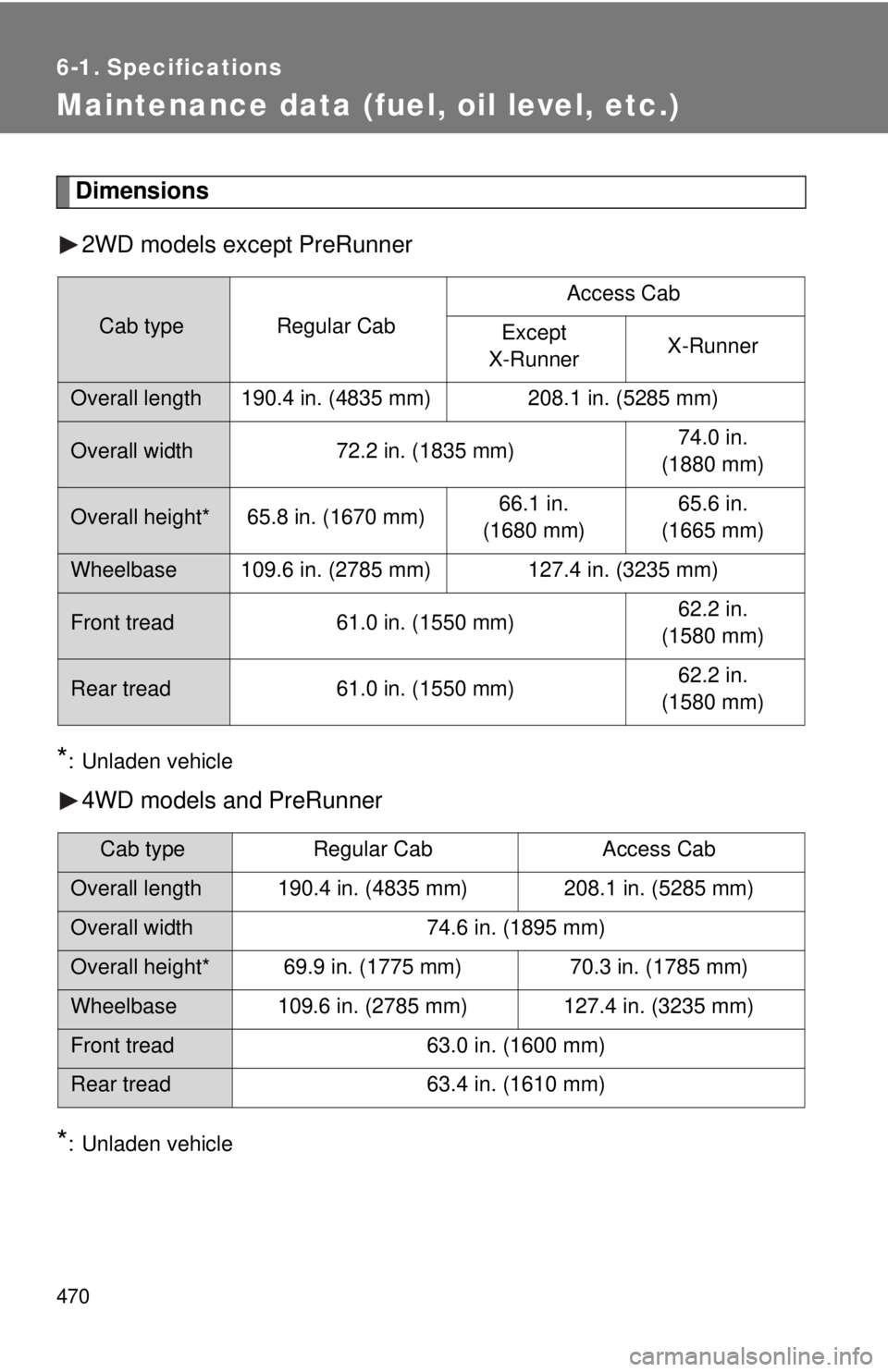
470
6-1. Specifications
Maintenance data (fuel, oil level, etc.)
Dimensions
2WD models except PreRunner
*: Unladen vehicle
4WD models and PreRunner
*: Unladen vehicle
Cab typeRegular Cab
Access Cab
Except
X-RunnerX-Runner
Overall length 190.4 in. (4835 mm) 208.1 in. (5285 mm)
Overall width 72.2 in. (1835 mm)74.0 in.
(1880 mm)
Overall height* 65.8 in. (1670 mm)66.1 in.
(1680 mm)65.6 in.
(1665 mm)
Wheelbase 109.6 in. (2785 mm) 127.4 in. (3235 mm)
Front tread 61.0 in. (1550 mm)62.2 in.
(1580 mm)
Rear tread 61.0 in. (1550 mm)62.2 in.
(1580 mm)
Cab typeRegular CabAccess Cab
Overall length 190.4 in. (4835 mm) 208.1 in. (5285 mm)
Overall width 74.6 in. (1895 mm)
Overall height* 69.9 in. (1775 mm) 70.3 in. (1785 mm)
Wheelbase 109.6 in. (2785 mm) 127.4 in. (3235 mm)
Front tread 63.0 in. (1600 mm)
Rear tread 63.4 in. (1610 mm)
Page 471 of 532
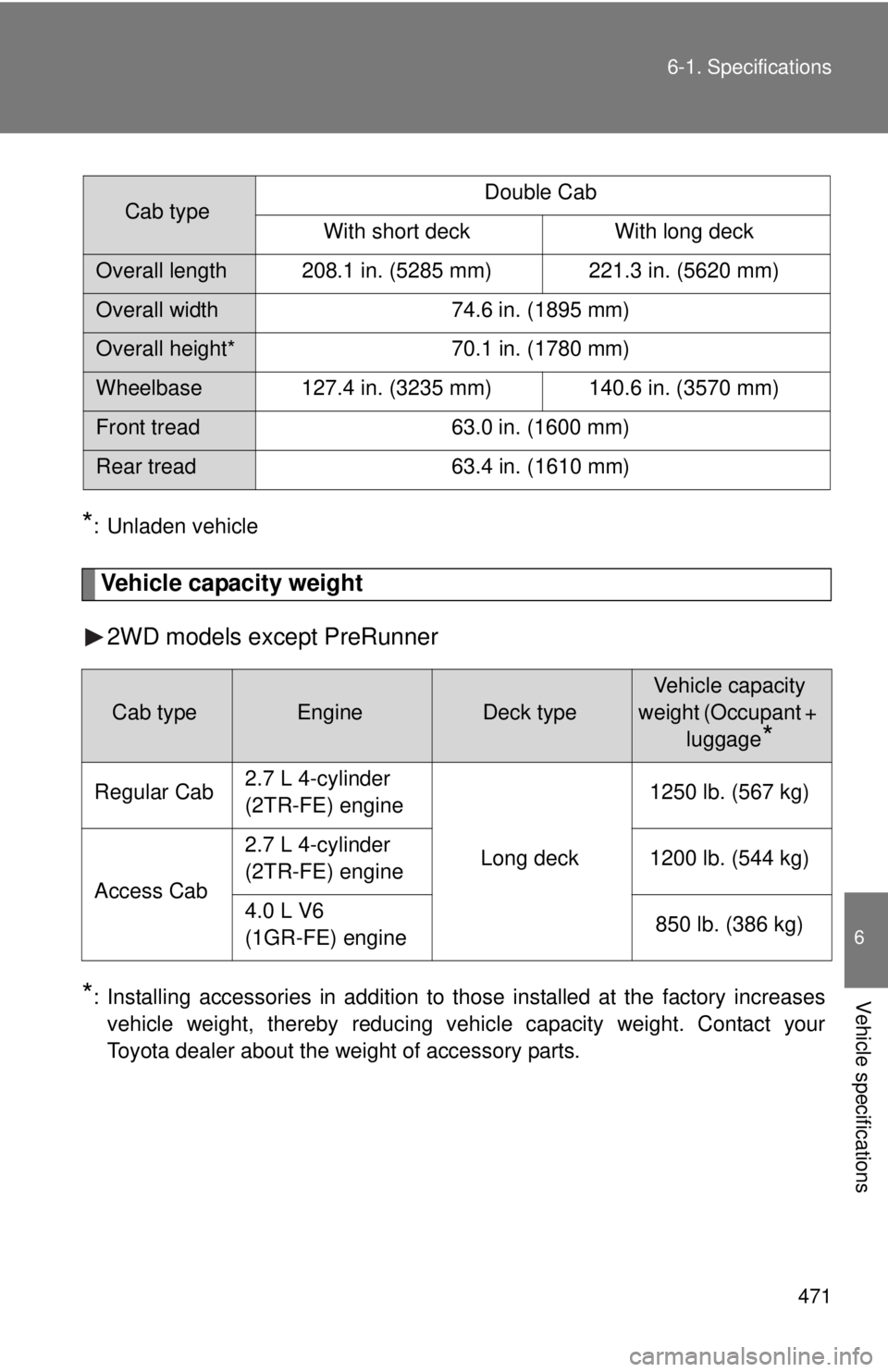
471 6-1. Specifications
6
Vehicle specifications
*: Unladen vehicle
Vehicle capacity weight
2WD models except PreRunner
*: Installing accessories in addition to those installed at the factory increases
vehicle weight, thereby reducing vehicle capacity weight. Contact your
Toyota dealer about the weight of accessory parts.
Cab typeDouble Cab
With short deckWith long deck
Overall length 208.1 in. (5285 mm) 221.3 in. (5620 mm)
Overall width 74.6 in. (1895 mm)
Overall height* 70.1 in. (1780 mm)
Wheelbase 127.4 in. (3235 mm) 140.6 in. (3570 mm)
Front tread 63.0 in. (1600 mm)
Rear tread 63.4 in. (1610 mm)
Cab typeEngineDeck type
Vehicle capacity
weight (Occupant +
luggage
*
Regular Cab2.7 L 4-cylinder
(2TR-FE) engine
Long deck
1250 lb. (567 kg)
Access Cab
2.7 L 4-cylinder
(2TR-FE) engine1200 lb. (544 kg)
4.0 L V6
(1GR-FE) engine850 lb. (386 kg)
Page 493 of 532
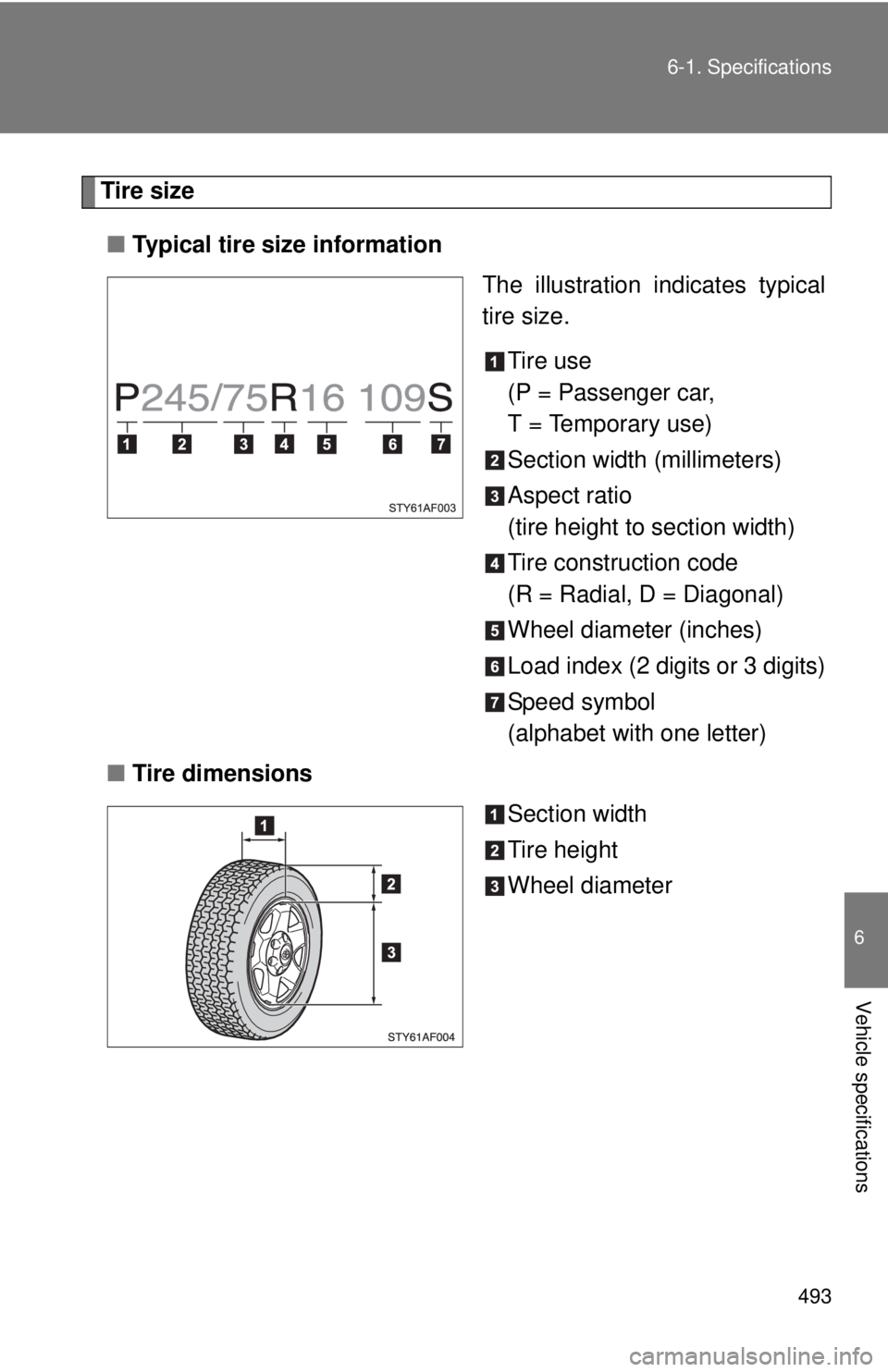
493 6-1. Specifications
6
Vehicle specifications
Tire size
■Typical tire size information
The illustration indicates typical
tire size.
Tire use
(P = Passenger car,
T = Temporary use)
Section width (millimeters)
Aspect ratio
(tire height to section width)
Tire construction code
(R = Radial, D = Diagonal)
Wheel diameter (inches)
Load index (2 digits or 3 digits)
Speed symbol
(alphabet with one letter)
■Tire dimensions
Section width
Tire height
Wheel diameter